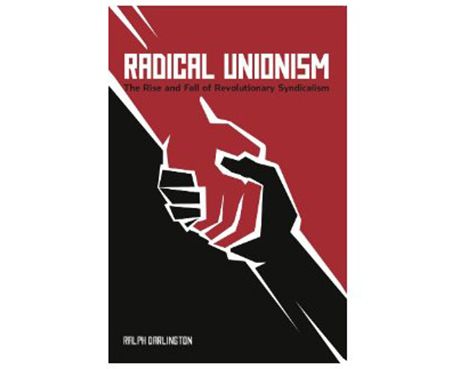Arts
You are here
Radical Unionism: The Rise and Fall of Revolutionary Syndicalism

May 18, 2017
Ralph Darlington’s Radical Unionism: The Rise and Fall of Revolutionary Syndicalism is a valuable piece of revolutionary history and a useful read for anyone trying to get a good sense of the dominant radical labour traditions of the last 150 years.
Darlington traces the rise and demise of revolutionary syndicalism, as exemplified by the cases of the Confederación Nacional del Trabajo (CNT) in Spain, the Confédération générale du travail (CGT) in France, the Unione Sindicale Italiana (USI) in Italy, the Irish Transport and General Workers’ Union (ITGWU), the Industrial Syndicalist Education League (ISEL) in Britain and the Industrial Workers of the World (IWW) in the US.
Radical upsurge
As Darlington explains: “during the first two decades of the twentieth century, amidst an extraordinary international upsurge in strike action, the ideas of revolutionary syndicalism connected with, and helped to produce, mass workers’ movements in a number of different countries across the world. An increasing number of syndicalist unions, committed to destroying capitalism through revolutionary trade union struggle, were to emerge as either existing unions were won over to syndicalist principles of new alternative revolutionary unions and organizations were formed by dissidents who broke away from their mainstream reformist adversaries. This international movement experienced its greatest vitality in the period immediately preceding and following the First World War, from about 1910 until the early 1920s.”
The popularity of syndicalism reflected a growing radicalism in the international labour movement during that period and grew out of anger at the inability of social democratic parties and mainstream trade unions to deliver real improvements in conditions for the working class. Syndicalism was attractive to those who saw parliamentary democracy and the conservatism, bureaucracy and corruption of the established socialist parties and trade unions as barriers to worker’s power and liberation.
Instead, syndicalists saw the hope of a better world for the working class in reconstructed and class-based (rather than craft-based) unions that would be militant organizations dedicated to the destruction of capitalism and the state through the intensification of industrial struggle. The general strike was the height of the struggle and, according to syndicalists, could achieve the overthrow of capitalism as unions became elevated to the frontline of struggle and could be turned into organs of economic and industrial administration after the overthrow of the old order.
Through the stories of the IWW, CGT, CNT and others, Darlington paints an inspiring picture of a real working class movement that organized outside the established labour organizations and put struggle and workers’ agency at the very centre of their vision for a better world.
Overtaken
The second half of the book details some of the reasons why this movement died. Primarily, the role of another insurgent method of socialism from below that also put the self-activity of workers at the centre of its vision for a new world: the revolutionary socialism of the Russian Bolshevik Party.
The victory of the working class revolution in Russia in October 1917 had the effect of winning many individual syndicalists converts and throwing into disarray the remaining syndicalist organizations. Darlington tries to summarize the relationship between syndicalism and the communism of Lenin’s Bolsheviks and their legacy for the theory and practice of working class liberation in the last chapter:
“The syndicalist movement not only made a considerable and enduring contribution to the explosive wave of working class struggle that swept the world during the first two decades of the twentieth century (as well as Spain during the 1930s), but was itself a direct expression of workers’ rising level of organization, confidence and class-consciousness during this period. The movement displayed a powerful and inspiring capacity to mount uncompromising anti-capitalist forms of struggle which challenged both the structures of managerial authority within the capitalist enterprise and the legitimacy of ‘democratic’ state power within society generally. In the process it provided a devastating critique of the prevailing versions of political labourism and state socialism, as well as of bureaucratic and conservative trade union officialdom.”
However, “its efficacy as a strategy for the revolutionary transformation of society, can be seen to have been overtaken by a more developed and richer Marxist tradition. Of course, there were a number of commonalities between the two traditions, such as the advocacy of revolution from below and the self-emancipation of the working class, the antipathy displayed towards reformist socialist party and trade union leaders, and the attempt to transform the unions into revolutionary bodies. And to some extent the revolutionary Marxist tradition was itself refined as a result of the influence of syndicalism, notably with the placing of trade union struggle at the very core of the communist project. But the Marxist tradition also crucially pointed to a number of crucial limitations within the syndicalist tradition, including: the need to link industrial struggle to political issues of broader nature and to direct such struggles towards the conquest of state power via insurrection; the need for a revolutionary political party that provided centralised leadership inside the working class movement; and the insufficiency of unions compared to soviets as the chief agency of revolution and organs of workers’ power.”
Radical Unionism is a great resource for those looking to understand the history of the labour movement, especially in the US, during the first two decades of the twentieth century. It is also key for understanding what Rosa Luxemburg meant when she warned about the separation of economics and politics and underlines her argument that political and economic struggles are interconnected and that relationship is essential to topple capitalism and transform the system into one that is much more humane.
Section:










